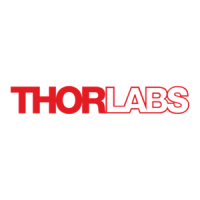© 2016 Thorlabs Scientific Imaging54
DCx Camera Functional Description and SDK Manual
Programming:
is_IO()
2.8.1 Using Digital Inputs/Outputs
Digital input (trigger)
Models with optocoupler input can use the digital input for externally triggering the image capture,
or query the applied signal level.
In trigger mode, a digital signal is applied to the camera's input. You can determine whether the
camera will respond to the rising or falling edge of the digital signal. After an internal delay, the
sensor is exposed for the defined exposure time. The captured image is then transferred to the
PC.
On models with general purpose I/Os (GPIO), you can query a voltage level at these inputs (TTL
compatible).
Digital output (flash)
The digital outputs can be used in both freerun mode and trigger mode. You can synchronize the
output level to the exposure time or set it statically.
Models with optocoupler output allow control of a DC voltage applied to the output. This allows
controlling a flash, either directly or via a separate flash controller unit. Models with general purpose
I/Os (GPIO) can output a voltage at these outputs (TTL compatible).
Note
Please read the notes on I/O wiring for your camera model in the Electrical specifications chapter.
Note
The settings specified for the digital output will be reset when the camera is disconnected from the
PC or the PC is powered down.
2.8.2 Flash Timing (Trigger Mode)
When using the digital output for flash control, you can set the delay and the duration of the flash.
The flash timing can be adjusted manually or automatically by the camera driver.
Note
Sensor latency and delay times The sensor latency is due to a number of technical factors,
including sensor type, image geometry, pixels clock and, with CCD sensors, the exposure time.
The latency is constant for a specific combination of parameters.
Trigger delay, flash delay and flash duration are optional and can be set by software.
The following illustrations show a schematic view of the image capture sequence. The sensor
exposure and readout times and the transmission times depend on the camera model and the
current parameter settings.
Automatic flash
If flash delay = 0 and flash duration = 0, the flash signal is automatically synchronized to the
exposure time. The automatic flash feature has the advantage that the flash is synchronized
automatically if the settings for image geometry or camera timing are changed. The disadvantage
is that the flash signal is active slightly longer than the exposure time. The flash duration with
automatic flash is longer for rolling shutter sensors than for global shutter sensors.

